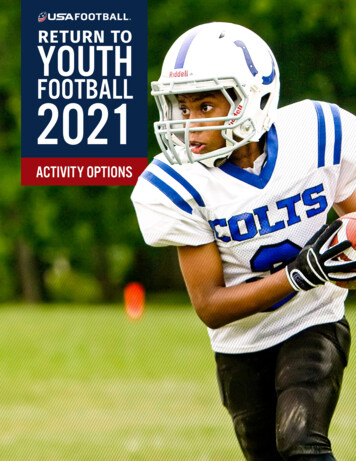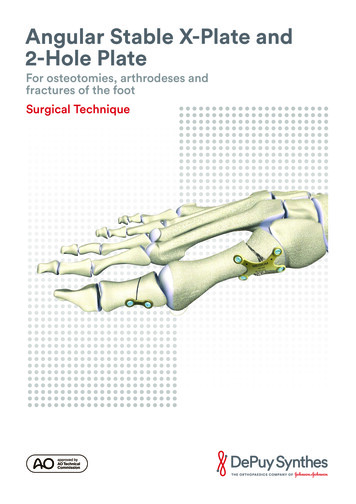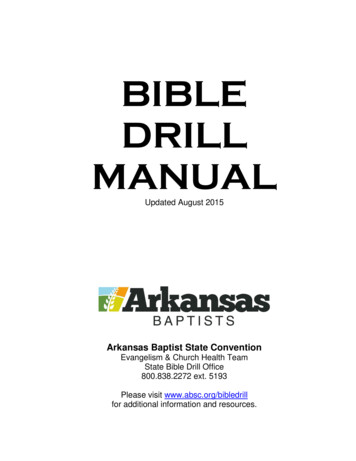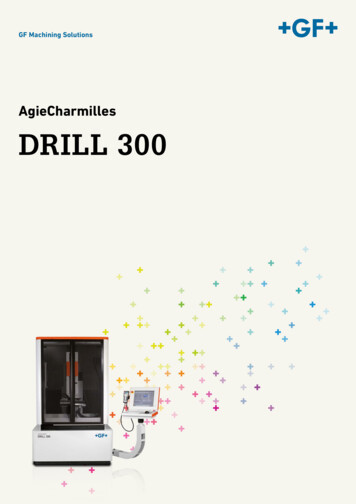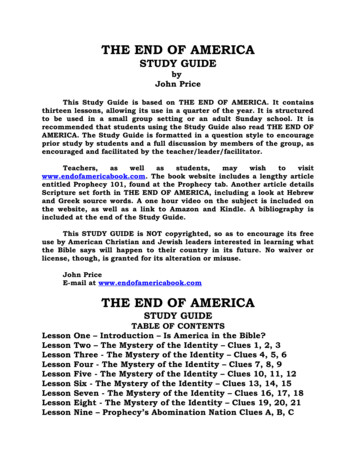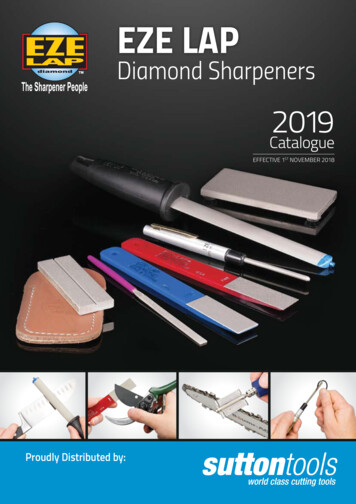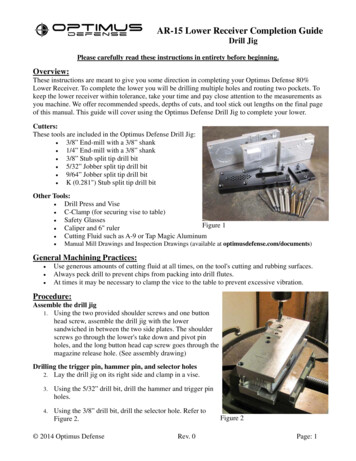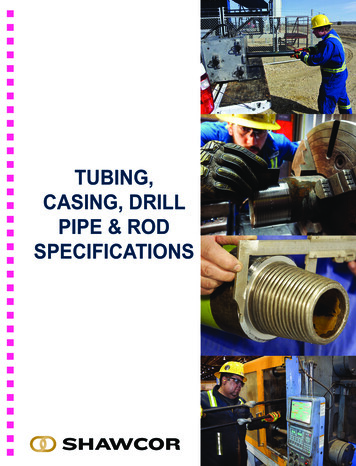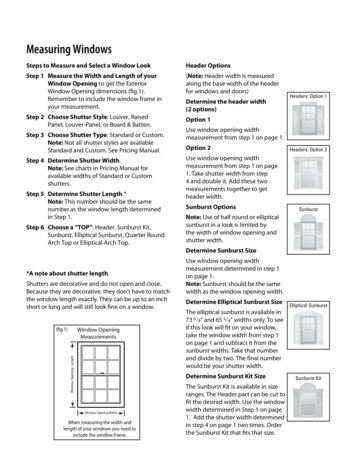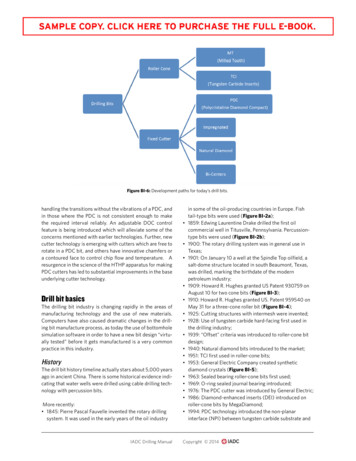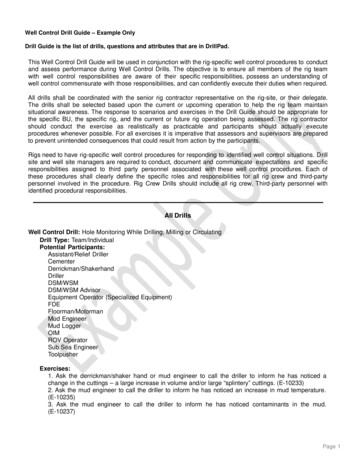
Transcription
Well Control Drill Guide – Example OnlyDrill Guide is the list of drills, questions and attributes that are in DrillPad.This Well Control Drill Guide will be used in conjunction with the rig-specific well control procedures to conductand assess performance during Well Control Drills. The objective is to ensure all members of the rig teamwith well control responsibilities are aware of their specific responsibilities, possess an understanding ofwell control commensurate with those responsibilities, and can confidently execute their duties when required.All drills shall be coordinated with the senior rig contractor representative on the rig-site, or their delegate.The drills shall be selected based upon the current or upcoming operation to help the rig team maintainsituational awareness. The response to scenarios and exercises in the Drill Guide should be appropriate forthe specific BU, the specific rig, and the current or future rig operation being assessed. The rig contractorshould conduct the exercise as realistically as practicable and participants should actually executeprocedures whenever possible. For all exercises it is imperative that assessors and supervisors are preparedto prevent unintended consequences that could result from action by the participants.Rigs need to have rig-specific well control procedures for responding to identified well control situations. Drillsite and well site managers are required to conduct, document and communicate expectations and specificresponsibilities assigned to third party personnel associated with these well control procedures. Each ofthese procedures shall clearly define the specific roles and responsibilities for all rig crew and third-partypersonnel involved in the procedure. Rig Crew Drills should include all rig crew, Third-party personnel withidentified procedural responsibilities.All DrillsWell Control Drill: Hole Monitoring While Drilling, Milling or CirculatingDrill Type: Team/IndividualPotential Participants:Assistant/Relief DSM/WSM AdvisorEquipment Operator (Specialized Equipment)FDEFloorman/MotormanMud EngineerMud LoggerOIMROV OperatorSub Sea EngineerToolpusherExercises:1. Ask the derrickman/shaker hand or mud engineer to call the driller to inform he has noticed achange in the cuttings – a large increase in volume and/or large “splintery” cuttings. (E-10233)2. Ask the mud engineer to call the driller to inform he has noticed an increase in mud temperature.(E-10235)3. Ask the mud engineer to call the driller to inform he has noticed contaminants in the mud.(E-10237)Page 1
4. Ask the mud logger to call the driller to inform he has noticed an increase in pit volume or anincrease in flow rate coming out of the well. (E-10238)5. Ask the driller or mud engineer to transfer a known quantity of mud from the reserve mud systeminto the active mud system and then ask the derrickman/shaker hand to measure the change in activepit volume following the transfer. (E-10378)6. Prepare the driller ahead of time and instruct him/her to NOT shut the well in. After briefing thedriller and without notifying the mud logger ahead of time, have the Tool Pusher simulate an increasein pit volume or flow rate utilizing the agreed to technique (manually raising pit level float, drainingmud from degasser, transferring mud from slugging pit, manually manipulating the flow indicator,utilizing a dedicated “training” line, etc.) (E-10227)7. Prepare the driller for this exercise ahead of time and instruct him/her not to respond when the mudlogger calls and to NOT shut the well in. After briefing the driller and without notifying the Mud Logger,have the tool pusher simulate an increase in pit volume or flow rate from the well utilizing the agreedto technique (manually raising pit level float, draining mud from degasser, transferring mud fromslugging pit, manually manipulating the flow indicator, utilizing a dedicated “training” line, etc.) . As analternative ask the mud logger to call the driller to inform he has noticed an increase in pit volume oran increase in flow rate (E-10250)8. Prepare the driller ahead of time and instruct him/her to play the role of a “belligerent” driller and toNOT shut the well in. After briefing the driller and without notifying the mud logger, have the toolpusher simulate an increase in pit volume or flow rate from the well utilizing the agreed to technique(manually raising pit level float, draining mud from degasser, transferring mud from slugging pit,manually manipulating the flow indicator, utilizing a dedicated “training” line, etc.). As an alternativeask the mud logger to call the driller to inform he has noticed an increase in pit volume or an increasein flow rate (E-10251)9. Individual Assessment Relevant Equipment (E-11137)10. Shallow Flow to Seafloor with no stack installed (E-11175)Attributes:Business Unit: XXX; Rig Type: Over Water Subsea Stack;Regular Caution Guidance:1. Be prepared to prevent closing the BOP if it is not desired or safe.2. If a BOP element is closed during the drill, ensure the element is opened prior to resumingoperations.3. Ensure the driller is aware of the exercise ahead of time and be prepared to stop him/her fromshutting in the well in case they forget.Assessment Guidance:1. Was the individual's reaction and response appropriate?2. Was the rig specific procedure followed and reinforced? Was the rig specific procedure reviewedto ensure compliance once the well/rig was established in a safe or static condition?3. Was the Derrickman or Shaker Hand calculation within 5 bbls of the actual volume transferred4. Record the time required to identify any increase in pit volume or flow rate (if an influx wassimulated).5. Did The Individual understand the purpose, functioning, maintenance, calibration of the chosenequipment or the process / procedure discussed?6. Are all personnel involved in the drill aware of their roles and responsibilities?7. Confirm roles and responsibilities are understood during the drill8. Observe crew. Was the crew able to execute their assigned responsibilities? Was communicationbetween crew members effective? Were any special instructions from supervision followed?9. Observe driller, was his reaction appropriate?Page 2
Questions: Select from the following (direct appropriate questions to specific individuals to encouragefull team participation) 1. What is our primary well control barrier? What is our secondary well control barrier? (Q-10629)2. What are the potential warning signs for a kick and why is each warning sign a possible kickindicator? (Q-10102)3. What equipment do you have to identify potential warning signs of a kick? What are the currentalarm setting for the equipment and what is the rationale for each alarm setting? (Q-10254)4. Does the equipment that helps you detect kick warnings and indications require calibration? If so,how frequently? When was the last time the equipment was calibrated? (Q-10263)5. What are the possible warning signs of a kick that you might have the opportunity to observe?(Q-10256)6. What action should be taken in response to observation of a possible kick indicator? (Q-10064)7. What is a drilling break? What action should be taken when you observe a drilling break? Why doyou take this action? (Q-10054)8. When conducting a flow check, how do you determine if the well is flowing? How long should youobserve the well before you are confident it is not flowing? (Q-10104)9. What is ballooning? What are the indications of ballooning? Is it possible for ballooning to occur ifthe well has not experienced losses? What action should you take if you suspect the well is ballooning?(Q-10085)10. Under current well conditions is there a potential for the well to kick if massive loss circulation isencountered? If so why, and if not, why not? What action should you take if massive loss circulationoccurs? At what point should the well be shut in? (Q-10053)11. What are the positive indicators of a kick? (Q-10072)12.What equipment do you have to identify positive signs of a kick? What are the current alarm settingfor the equipment and what is the rationale for each alarm setting? (Q-10262)13. What action should be taken in response to observation of a positive kick indicator? (Q-10063)14. What action should be taken if you notice a change in cuttings volume, size or shape? What coulda noticeable change in cuttings indicate from a well control perspective? (Q-10224)15. What action should be taken if the derrickman or shaker hand reports a noticeable change incuttings volume, size or shape? What could a noticeable change in cuttings indicate from a wellcontrol perspective? (Q-10058)16. What action should be taken if you notice water or base oil being added to the mud pit with nomud engineer in attendance overseeing the addition? (Q-10226)17. What action should be taken if the derrickman or shaker hand reports water or base oil beingadded to the mud pit with no mud engineer in attendance overseeing the addition? (Q-10130)18. What action should be taken if you detect an increase in mud temperature coming out of the well?What could an increase in temperature indicate from a well control perspective? (Q-10257)19. What action should be taken if the mud engineer reports he has detected an increase in mudtemperature coming out of the well? What could an increase in temperature indicate from a wellcontrol perspective? (Q-10059)20. What action should be taken if you detect unexplained contaminants in the mud? What couldunexplained contaminants indicate from a well control perspective? (Q-10258)21. What action should be taken if the mud engineer reports he has detected unexplainedcontaminants in the mud? What could unexplained contaminants in the mud indicate from a wellcontrol perspective? (Q-10060)Page 3
22. What action should be taken if an increase in pit volume or flow rate from the well is reported bythe mud logger and you have not noticed the same on your monitoring equipment? (Q-10056)23. What action should be taken if you notice an increase in pit volume or flow rate from the well?What does an increase in pit volume or flow rate indicate? (Q-10225)24. What action should be taken if you notice an increase in pit volume? (Q-10554)25. What action should you take prior to transferring fluids or making additions to the mud systemwhich will result in an increase in pit volume? (Q-10260)26. What action should be taken if you call the driller to report you have noticed an increase in pitvolume or flow rate from the well and he continues drilling and does not take any action? (Q-10264)27. What action should be taken if you call the driller to report an increase in pit volume or anincrease in flow rate from the well and he does not answer? (Q-10265)28. What is the current alarm setting for the PVT equipment? What is the rationale for this setting?(Q-10088)29. What is the current alarm setting for the flow indicator (FloSho)? What is the rationale for thissetting? (Q-10087)30. What action should you take if an H2S alarm goes of at the rig floor or the shale shakers?(Q-10383)31. What action should be taken if an H2S alarm goes off at the drill floor or the shale shakers?(Q-10376)32. What is an underground blowout? What are the indications of an underground blowout? What arethe first actions you should take if you suspect an underground blowout is occurring? (Q-10377)33. Discuss the chosen components of the relevant equipment:- Purpose and importance- How it functions- How it is maintained and calibrated- Who must be notified if a fault is suspected or identified.- Other topics/questions (Q-11139)Attributes:Business Unit: XXX;34. When drilling with returns to the seafloor, what is the communication protocol on this rig if a kick isobserved? (Q-11176)Attributes:Business Unit: XXX; Rig Type: Over Water Subsea Stack;35. When Drilling with returns to the seafloor, where should ROV be stationed and how should thewell be monitored?If visibility is poor what other means are available to monitor the well with ROV?What action is taken if the ROV becomes inoperable?(Q-11177)Attributes:Business Unit: XXX; Rig Type: Over Water Subsea Stack;36. When drilling with returns to the seafloor, what is the initial response that needs to be taken in theevent an influx is observed?How is a kick detected during Riserless drilling?How can a gas flow be differentiated from a water flow?What is the kill procedure if shallow gas/water flow is observed?What is the pre-determined kill mud weight or will straight pad mud be pumped? (Q-11178)Page 4
Attributes:Business Unit: XXX; Rig Type: Over Water Subsea Stack;37. When drilling with returns to the seafloor, How is a kick detected?What is the initial response that needs to be taken in the event an influx is observed?Does the rig have a Shallow Water Flow plan?What is the kill procedure if shallow gas/water flow is observed?How can the type of flow (gas or water) flow be distinguished?Had a pre-determined kill mud weight been identified or will straight pad mud be pumped?What is the pad mud weight and is there sufficient amount of mud available to perform kill?In the event of a flow will the DKD unit to blend kill mud weight will two rig pumps be used with padmud and seawater?Is there a move-off a plan with preferred direction? (Q-11182)Attributes:Business Unit: XXX; Rig Type: Over Water Subsea Stack;Skills Assessed:CommunicationsComplication KnowledgePositive Kick IndicatorsPossible Kick IndicatorsProcedural ExecutionProcedural KnowledgeSupervision of SubordinatesWell Control TheoryWell Control Drill: Shut-in While Drilling or Milling/CirculatingDrill Type: Team/IndividualPotential Participants:Assistant/Relief DSM/WSM AdvisorEquipment Operator (Specialized Equipment)FDEFloorman/MotormanMud EngineerMud LoggerROV OperatorSub Sea EngineerToolpusherExercises:1. Without notifying the driller ahead of time, simulate an increase in pit volume using the agreed totechnique (manually raising pit level float, draining mud from degasser, transferring mud from sluggingpit, etc.). (E-10001)Page 5
2. Without notifying the driller ahead of time, simulate an increase in flow rate from the well using theagreed to technique (manually manipulating the flow indicator, using a dedicated “training” line, etc.).(E-10002)3. Without notification to the Driller, line up and have the cementer pump mud to the trip tank(E-11113)Attributes:Rig Type: Land Rig; Over Water Subsea Stack; Over Water Surface Stack;4. Without notification to the Driller, have the cementer pump mud to the Stripping Tank. Then havethe Subsea Team bleed the Stripping Tank into the Trip Tank (Subsea (E-11114)Attributes:Rig Type: Over Water Subsea Stack;5. Have the driller informed that an influx has been taken. (E-10211)6. Individual Assessment Relevant Equipment (E-11137)Regular Caution Guidance:1. Be prepared to prevent closing the BOP if it is not desired or safe.2. If a BOP element is closed during the drill, ensure the element is opened prior to resumingoperations.Assessment Guidance:1. Record the time required to identify any increase in pit volume or flow rate (if an influx wassimulated).2. Record the time required for the rig team to complete the shut-in.3. Observe rig crew. Was the crew able to execute their assigned responsibilities? Wascommunication between crew members effective? Were any special instructions from the drillerfollowed?4. Observe the driller. Were the driller’s reaction and the direction provided to the crew membersappropriate? Were the driller's communications with other personnel on the rig appropriate andeffective?5. Was the rig specific procedure followed and reinforced? Was the rig specific procedure reviewedto ensure compliance once the well/rig was established in a safe or static condition?6. Did The Individual understand the purpose, functioning, maintenance, calibration of the chosenequipment or the process / procedure discussed?Questions: Select from the following (direct appropriate questions to specific individuals to encouragefull team participation) 1. What is our primary well control barrier? What is our secondary well control barrier? (Q-10629)2. What are the specific responsibilities for each member of the drilling crew when executing the shutin procedures while drilling? (Q-10073)3. Which element of the stack should be closed when shutting in the well due to an influx whiledrilling? Why is this element used as opposed to another element on the stack? (Q-10110)4. How do you confirm the well has been shut-in? (Q-10027)5. What is a hard shut-in. What is the primary objective of a hard shut in? (Q-10372)6. What are your specific responsibilities when executing the shut-in procedure while drilling, millingor circulating? (Q-10270)7. What action should you take if an increase in pit volume or flow rate from the well is reported by themud logger and you have not noticed the same on your monitoring equipment. (Q-10269)8. What is the distance from the rotary table to the uppermost set of pipe rams? (Q-10092)Page 6
9. How should the well be monitored during shut-in and prior to executing the well kill procedure?How will you ensure the BOP element closed is not leaking? (Q-10042)10. What parameters should be recorded after shutting in on a well kick? (Q-10094)11. Where do you monitor the Shut-in Drill Pipe Pressure (SIDPP) and Shut-in Casing Pressure(SICP)? (Q-10108)12. Why is it important to monitor the Shut-in Drill Pipe Pressure (SIDPP) and Shut-in CasingPressure (SICP)? (Q-10115)13. Should the pipe be moved if the well is shut-in for an extended period of time prior to commencingwell kill operations? If so, how? (Q-10052)14. What are the positive indicators of a kick? (Q-10072)15. What action should be taken in response to observation of a positive kick indicator? (Q-10063)16. What are the normal pressure readings for the following gauges on your rig's accumulator system:1) rig air, 2) accumulator bank, 3) manifold and 4) annular? (Q-10373)17. What is the primary function of the weep holes on a ram type BOP? (Q-10384)18. How will BOP system performance be affected if the nitrogen pre-charge pressure is lost in anaccumulator bottle? (Q-10374)19. Discuss the chosen components of the relevant equipment:- Purpose and importance- How it functions- How it is maintained and calibrated- Who must be notified if a fault is suspected or identified.- Other topics/questions (Q-11139)Attributes:Business Unit: XXX;Complications:Well Continues To FlowQuestions:1. What action should you take if the well continues to flow after the BOP is initially closed?(Q-10065)Gas MigrationQuestions:1. How can you identify gas migration? What should you do if you determine gas is migratingwhile the well is shut-in? (Q-10026)2. What effect does gas migration have on a shut-in well? (Q-10083)Gas In the RiserAttributes:Rig Type: Over Water Subsea Stack;Questions:1. How will you know if there is gas in the riser after shut-in? (Q-10276)Attributes:Rig Type: Over Water Subsea Stack;2. What action should be taken if there is gas in the riser after the well is shut-in? (Q-10279)Attributes:Rig Type: Over Water Subsea Stack;Skills Assessed:Page 7
CommunicationsComplication KnowledgePositive Kick IndicatorsProcedural ExecutionProcedural KnowledgeSupervision of SubordinatesWell Control TheoryWell Control Drill: Shut-in While TrippingDrill Type: Team/IndividualPotential Participants:Assistant/Relief DSM/WSM AdvisorEquipment Operator (Specialized Equipment)FDEFloorman/MotormanMud EngineerMud LoggerOIMRig ManagerROV OperatorSub Sea EngineerToolpusherExercises:1. While tripping and without notifying the driller ahead of time, simulate an increase in pit volumeusing the agreed to technique (manually raising pit level float, draining mud from degasser, transferringmud from slugging pit, etc.). (E-10407)2. While tripping have the driller informed that an influx has been taken. (E-10420)3. While tripping out of the hole inform the driller the well is experiencing severe losses (E-10520)4. In a pre-tour discussion or during a detailed JSA; discuss the upcoming operation including nonroutine string components which are either non-shearable or non-sealable when adjacent to the BOP.(E-10847)5. Without notification to the Driller, line up and have the cementer pump mud to the trip tank(E-11113)Attributes:Rig Type: Land Rig; Over Water Subsea Stack; Over Water Surface Stack;6. Without notification to the Driller, have the cementer pump mud to the Stripping Tank. Then havethe Subsea Team bleed the Stripping Tank into the Trip Tank (Subsea (E-11114)Attributes:Rig Type: Over Water Subsea Stack;Page 8
7. Prepare the driller ahead of time and instruct him/her to play the role of a “belligerent” driller and toNOT shut the well in. After briefing the driller and without notifying the mud logger, have the toolpusher simulate an increase in pit volume or flow rate from the well utilizing the agreed to technique(manually raising pit level float, draining mud from degasser, transferring mud from slugging pit,manually manipulating the flow indicator, utilizing a dedicated “training” line, etc.). As an alternativeask the mud logger to call the driller to inform he has noticed an increase in pit volume or an increasein flow rate (E-10251)8. Prepare the driller ahead of time to sound the well control alarm and have all crew members reportto appropriate stations and perform appropriate duties, simulating an influx while tripping in/out of thehole. (E-10863)Regular Caution Guidance:1. Be prepared to prevent closing the BOP if it is not desired or safe.2. If a BOP element is closed during the drill, ensure the element is opened prior to resumingoperations.3. Ensure the driller is aware of the exercise ahead of time and be prepared to stop him/her fromshutting in the well in case they forget.4. Be prepared to prevent actual ROV Stab-In if it is not desired or safe.Assessment Guidance:1. Record the time required for the rig team to identify any simulated increase in pit volume.2. Record the time required for the crew to install and close the safety valve or IBOP, and then closethe BOP element (complete the shut-in)3. Observe rig crew. Was the crew able to execute their assigned responsibilities? Wascommunication between crew members effective? Were any special instructions from the drillerfollowed?4. Observe the driller. Were the driller’s reaction and the direction provided to the crew membersappropriate? Were the driller's communications with other personnel on the rig appropriate andeffective?5. Was the rig specific procedure followed and reinforced? Was the rig specific procedure reviewedto ensure compliance once the well/rig was established in a safe or static condition?6. Table Top Exercise The rig crews should be aware of any component that cannot be sheared orthe BOP will not seal against and should be able to demonstrate that they understand equipmentlimitations and specifically how the well would be shut in and secured for each specific non- shearabletubular. Did the driller and crew members demonstrate knowledge of the precautions or actionswhich must be taken prior to running the above components across the stack and the shut in proceduresassociated with them? Which the rig specific procedure should be followed and reinforced? Was therig specific procedure reviewed to ensure compliance?7. Record the time required to identify any increase in pit volume or flow rate (if an influx wassimulated).8. Was the individual's reaction and response appropriate?9. Are all personnel involved in the drill aware of their roles and responsibilities?10. Confirm roles and responsibilities are understood during the drill11. Did all crew members participate in the discussion? Was each able to explain their specificresponsibilities during a standard stripping operation?12. Did the discussion include how the BOP would be monitored during the stripping operation andthe action to take if a leak was greater than the intended weep?13. Did the discussion include how the BOP would be monitored for leaks during the kill operationand the action to take if a leak was identified?Page 9
14. Did the discussion include the circulation path for the mud during the stripping operation? Wasthe path and valve lineup correct?15. Did the discussion include the circulation path for the mud during the well kill operation? Was thepath and valve lineup correct?16. Did the discussion include the procedure to monitor the Mud/Gas Separator during the well killoperation?17. Did the discussion include the procedure to monitor the stripping tank during the strippingoperation?18. Did the discussion include who would operate the choke and the communication path?19. Did the discussion include who would operate the pump, who would operate the choke and howthey would communicate and coordinate their actions?Questions: Select from the following (direct appropriate questions to specific individuals to encouragefull team participation) 1. What is our primary well control barrier? What is our secondary well control barrier? (Q-10629)2. What are each crew members specific responsibilities when executing the shut-in procedure whiletripping? (Q-10290)3. What specific procedures do you use to monitor the hole for signs of an influx when tripping in thehole? When are you expected to conduct flow checks during a trip in the hole? (Q-10098)4. What specific procedures do you use to monitor the hole for signs of an influx when tripping out ofthe hole? When are you expected to conduct flow checks during a trip out of the hole? (Q-10099)5. What action should be taken if there is a discrepancy between the anticipated volume of muddisplaced from the hole and the actual volume observed when tripping in the hole? (Q-10067)6. What action should be taken if there is a discrepancy between the anticipated volume of mudrequired to fill the hole and the actual volume observed when tripping out of the hole? (Q-10068)7. What is the displacement volume of the pipe currently being tripped and is this value based uponopen ended or closed pipe? (Q-10090)8. If tripping operations are interrupted (for example due to mechanical issues), how should the wellbe secured and monitored during this time frame? (Q-10049)9. What are the specific responsibilities for each member of the drilling crew when executing the shutin procedures while tripping? (Q-10077)10. When should you use the Full Opening Safety Valve (FOSV)? (Q-10106)11. How is the Full Opening Safety Valve (FOSV) picked up and made up? What is the shut-inprocedure associated with the FOSV? Where is the wrench used to close the FOSV stored? (Q-10037)12. When should you use the Inside BOP (IBOP)? (Q-10107)13. How is the IBOP picked up and made up? What is the shut-in procedure associated with theIBOP? (Q-10039)14. When should you use an Full Opening Safety Valve (FOSV) and an Inside BOP (IBOP)?(Q-10105)15. Which element of the stack should you close when shutting in the well due to an influx whiletripping? Why is this element used as opposed to another element on the stack? (Q-10112)16. What parameters should be recorded after shutting in on a well kick? (Q-10094)17. What is the distance from the rotary table to the uppermost set of pipe rams? (Q-10092)18. What are three factors that could effect swabbing or surging? (Q-10078)Page 10
19. How are the operations being conducted going to change the well conditions? (ie, pumping lighterfluid, running non shearabales across BOP, changing down hole wellbore conditions by perforating orHydraulic Fracturing) (Q-10848)20. What is the planned communication protocol for this operation? Who is involved? (Q-10849)Complications:Well Continues To FlowQuestions:1. What action should you take if the well continues to flow after the BOP is initially closed?(Q-10065)Gas MigrationQuestions:1. How can you identify gas migration? What should you do if you determine gas is migratingwhile the well is shut-in? (Q-10026)2. What effect does gas migration have on a shut-in well? (Q-10083)Tripping While Taking LossesQuestions:1. Are you allowed to trip out of the hole if the well is taking losses? (Q-10011)2. How do you ensure the well will remain overbalanced? (Q-10029)3. Is there a limit to the loss rate before tripping operations are suspended? (Q-10051)4. How could losses occur during this operation? What impact would losses have? What are theloss contingencies?(Q-10850)Potential Issues With Non-shearables Across the BOPQuestions:1. What do you do if the rig loses power when non-shearables are across the stack? (Q-10489)Attributes:Rig Type: Over Water Subsea Stack;2. What do you do if the pipe is stuck while non- shearables are across the stack? (Q-10490)Perforating guns across the stack.Attributes:Rig Type: Over Water Subsea Stack;Questions:1. What is the correct action if the well starts to flow with spent guns across the stack?(Q-10682)Attributes:Rig Type: Over Water Subsea Stack;2. What do you do if the rig loses power with live guns across the stack? What about spentguns? (Q-10683)Attributes:Rig Type: Over Water Subsea Stack;Dual Gradient System or Riser Cap (Mud or Seawater/base oil) in HoleQuestions:1. How do we determine shut in pressure with a dual gradient column of fluid? (Q-10715)Page 11
2. When using a mud cap, how do you determine if the volume of mud pumped will be enoughto stop the well flow or address losses? How can you check to confirm your calculated height iscorrect? (Q-10716)3. How do you determine where to place the mud cap in the well? (Q-10718)4. Where should the riser cap be placed for POOH? What determines where you spot the capin the riser? (Q-10836)Attributes:Rig Type: Over Water Subsea Stack;5. Where should the riser cap be placed for TIH? What determines w
Well Control Drill Guide – Example Only . Drill Guide is the list of drills, questions and attributes that are in DrillPad. This Well Control Drill Guide will be used in conjunction with the rig-specific well control procedures to conduct and assess performance during Well Control Drills. The objective is to ensure all members of the rig team

